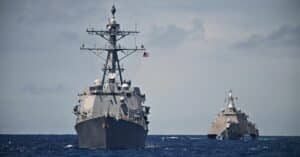
Spain Confiscates Cocaine Mixed With Salt for Animal Feed Shipped from Colombia
February 10, 2024
Mysterious Ship Capsizes Leading To Massive Oil Spill Off Tobago Coast
February 10, 2024
Warships of the U.S. Navy will stay in the waters of the Middle East for some time to face their enemies being aided by Iran.
Naval analysts say the current confrontations show the need for more sustainable weapons to tackle enemy drones.

Clark, a retired officer of the Navy, mentioned that the U.S. Navy is using surface-to-air missiles to shoot down some of the enemy drones, which is not very good from the cost exchange perspective. He also said that Ukraine is jamming Russian Drones, a viable strategy.
He added that a destroyer recently used the latest variant of the SM-2 missile, which cost $2.1 million, to destroy drones launched by Iran.
He suggested that the U.S. Navy could jam the guidance systems and control links of enemy drones, like Ukraine has been doing to Russian drones. He said the U.S. Navy could also develop lasers and microwave weapons for blasting the drones.
Though the Navy has access to laser models, they must employ them in battle.
He said, “I think that’s where the debate in the Navy has been: Do we wait for a bigger laser that can take down a cruise missile, or do we field smaller lasers today that can take out a drone?”
He said using a million-dollar missile against a thousand-dollar drone is not a good long-term strategy.
He expressed the urgency of using lasers to deal with drones rather than using expensive surface-to-air missiles against them.
Though the U.S. Navy has retaliated and shot most enemy drones, there have been close calls. In January, a ballistic missile fired by Houthis got close to a destroyer, and it had to employ its close-in weapon system, which is its last line of defence.
References: Business Insider, The Russophile
U.S Navy Needs More Counter-Drone Weapons To Face Houthis In the Middle East appeared first on Marine Insight – The Maritime Industry Guide
Source: Maritime Shipping News


